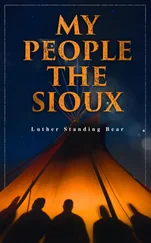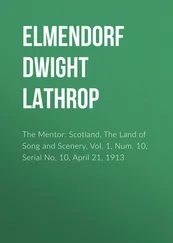For six or eight months I spent a good deal of time in one of these cradles. When camp was moving, mother put me on her back and wrapped me to her with her blanket. Sometimes she placed me on the travois for a journey, but not often. If she rode her pony, she first mounted, then I was handed to her. With her blanket she fastened me securely to her. When I became old enough to sit up, she put me astride the horse in front of her. I cannot, of course, remember the first time I rode this way, but neither can I remember learning to ride by myself.
Most of mother’s work was performed while carrying me in my cradle on her back. She packed and unpacked her horses and even put up her tipi while carrying me in this fashion.
When working in the tipi she often leaned my cradle against something so that I stood in an upright position. In this way I could look around and, no doubt, I watched mother’s movements as she worked, listened to her as she talked or sang little songs to me. If I fell asleep she took me out of the cradle and I slept while she watched.
Most of the time a Lakota infant was lightly and simply dressed, but a great deal of time and care went into the making of the material for garments. Mothers preferred a light-weight buckskin or unborn buffalo calf skin for such purposes. When properly tanned, no manufactured material can equal these skins in richness of texture and quality. When the process of tanning is complete, these skins are exquisitely white, richer in sheen than fine broadcloth, and softer than velvet. The Lakota woman washed these garments in water and by rubbing brought them back to their original softness and whiteness. Garments for dress wear were trimmed with fringe, quillwork, and paintings.
For sanitary purposes the down from the cottonwood tree pods was used. Also in the fall of the year cattails furnished a soft airy down, but the cottonwood down was preferable. No like article manufactured in mills can equal this down in silky fineness, so light it floated in the air on a still day. Besides, the supply was plentiful and the women kept it stored in large deerskin bags. For sanitary purposes finely powdered buffalo chips were also stored away and was most effectual in its intended purpose.
As the Lakota child continued to develop, it had the constant companionship of an elder; if not father or mother, then aunt, uncle, or one of the numerous cousins of the band. Children were always welcome charges of all who were older. Every child not only belonged to a certain family, but also belonged to the band, and no matter where it strayed when it was able to walk, it was at home, for everyone in the band claimed relationship. Mother told me that I was often carried round the village from tipi to tipi and that sometimes she saw me only now and then during the day. I would be handed from relative to relative and someone was constantly amusing me.
A large portion of the care of a child fell to its grandmother, and in some respects she was as important in the child’s life as the mother. The interest of the older women became centered on the welfare of children, and, possessing both experience and wisdom, they were much depended upon. This wisdom concerning the lore of taking care of little ones gave grandmother a superior position, especially with the younger women and mothers. It made a place for her as teacher and adviser in her band. It was, too, lighter work than carrying wood and water and tanning skins, these tasks being taken care of by the younger and stronger women.
Grandmothers became skilled in preparing food for children, and most of them had a host of little ones running after them all the time. When children became hungry, they nearly always ran to grandmother first for food and she was never found lacking in a supply. Nor were children ever refused in their request for food. There was a special delicacy which took time and patience to prepare and of which all children were fond. This was wasna and it was grandmother’s job to make it. Wasna was made of dried meat and dried choke-cherries pounded together, seeds and all, until it was a fine meal. This meal was thoroughly mixed with and held together in loaves or cakes by the fat skimmed from the boiled bones of the buffalo. It was not only a delicious food, but a health food good for young children beginning to eat solid food. No one claimed grandmother’s official job as wasna-maker.
Grandmother took care of all our toys. Our winter toys she stored away in the summer. When winter came she stored away the summer toys. She made pretty bags in which she laid away our marbles, tops, and other toys.
Most grandmothers seemed to be happiest when caring for a number of little ones. And I especially remember one grandmother for her fondness for children. This grandmother—I have forgotten her name—belonged to the band of my grandfather, Chief One Horse. This old lady lived to a great age, but before her death became stricken with blindness. With all this handicap she could not give up caring for her charges. One day she called all the children together and began painting their faces. This was a daily task for someone and it was her way of helping. The children all grouped about her, each waiting his turn. Her bags of paint were near and soon all the children were fixed up. But pretty soon the children began to feel a queer drawing sensation of the face as if it was being all puckered up into one spot. They began to look at one another and found that each little brown face was speckled with white and withered in places. Then curious mothers began to look their children over. It was soon discovered that grandmother had got her bags of salt mixed up with her bags of paint and each child was generously salted instead of painted. This incident became a great joke in the village. Everybody laughed, including grandmother herself. The joke became history, for her band was thereafter called Mini skuya ki cun, or, ‘The band that paints their faces with salt.’ It is so called to this day.
When I became old enough to walk, I spent much time in the tipi of my grandmother. If mother and father were going out for the evening and I did not care to go, I went and slept in grandmother’s tipi and I was always welcome. I remember my grandmother as a patient and tireless worker. She went on long walks gathering fruits and plants, and sometimes she took me with her. When I grew old enough to understand, she told me many things about their nature and usefulness. Much of her simple knowledge would be of value today.
In learning to talk, Lakota children were encouraged and helped, beginning about the same time as children of the white race. But there was no ‘baby talk’ for them. All speech in their presence was full and complete.
And so the days of my infanthood and childhood were spent in surroundings of love and care. In manner, gentleness was my mother’s outstanding characteristic. Never did she, nor any of my caretakers, ever speak crossly to me or scold me for failures or shortcomings. For an elder person in the Lakota tribe to strike or punish a young person was an unthinkable brutality. Such an ugly thing as force with anger back of it was unknown to me, for it was never exhibited in my presence. For this nobility alone I sing the praises of the Lakotas—this thing alone denotes them a brave people.
Mother was a comely woman, not very large but plump and rounded in form. Her face was soft in outline and her features were good. Her skin was light in color and fine in texture. Her long black hair she wore in two braids which hung one on each side of her face after the fashion of the women of her tribe. When she was a child she was quite pretty and possessed a sweetness of disposition. She was called Wastewin, or Pretty Face, and since it turned out that she became a belle in her tribe she was well named. Her name signified grace and goodness as well as good looks, and my mother possessed both of these qualities.
Читать дальше












